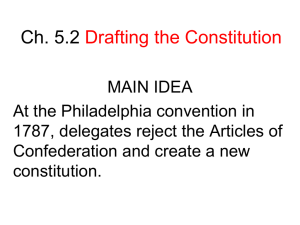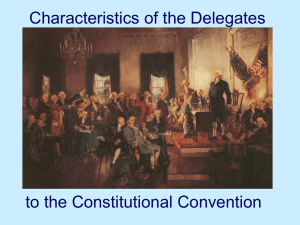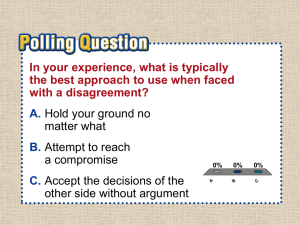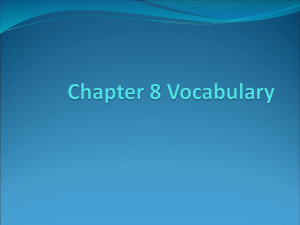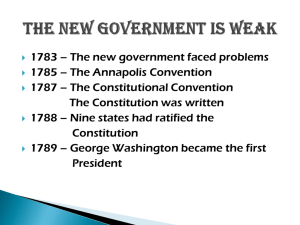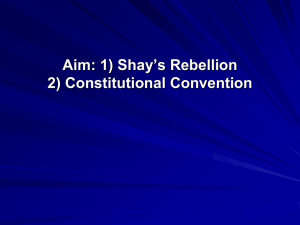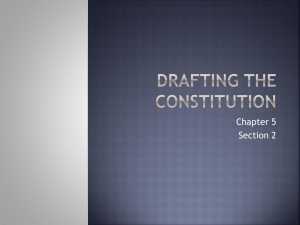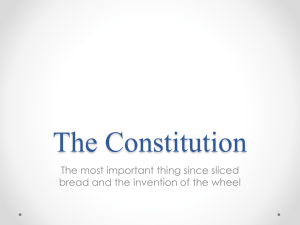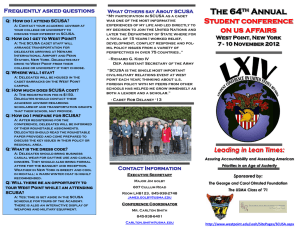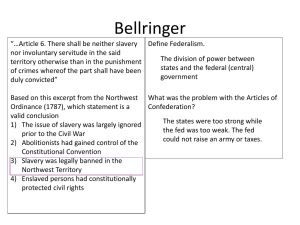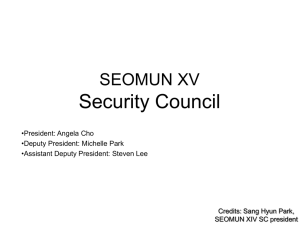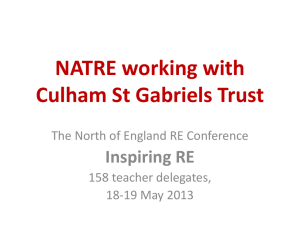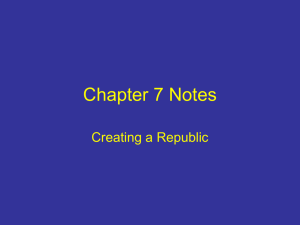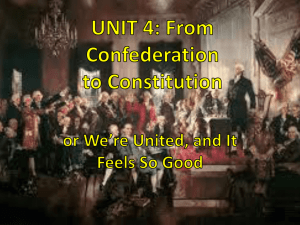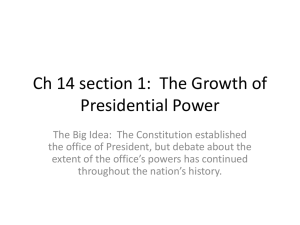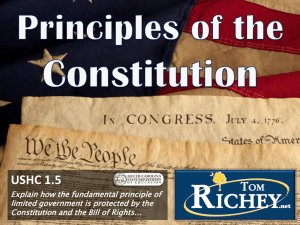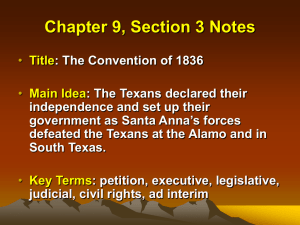Chapter 5 Section 2 *Drafting the Constitution*
advertisement
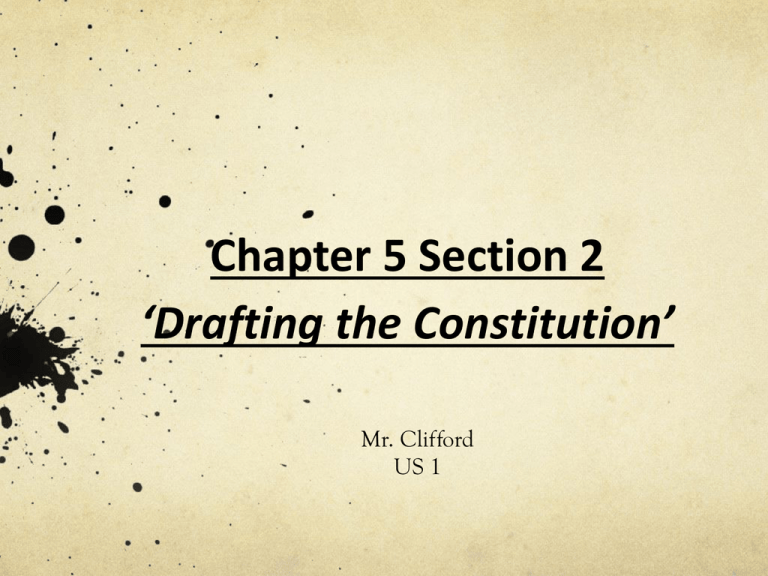
Chapter 5 Section 2 ‘Drafting the Constitution’ Mr. Clifford US 1 CREDITORS vs. DEBTORS Continental Soldiers returned home from the war unable to pay their taxes/loans. Many had taken loans from creditors to maintain farms, livestock, etc. Many soldiers did not receive pay from Continental Army. All states governments were in debt and levied high taxes on citizens. Economic depression Farmers who did not repay their debt were subjected to debtor’s prison or loss of property/possessions to repay debts. Farmers believed they were the victims of too much taxation. Farmers are fed up! Shays Rebellion: Approximately 1200 Massachusetts farmers rebel and force MA state courts to shut down in response to state courts seizing MA famers’ property, livestock, and crops for not paying off their debt. Daniel Shays: the leader of the rebellion marched the mob to the federal arsenal in Springfield, MA to overthrow the Massachusetts State House. The rebels were eventually stopped by the Mass. Militia. The rebellion scared state governments. The Articles of Confederation FAILES All 13 states were concerned about possible rebellions by citizens or those states. George Washington and others knew that the Articles of Confederation had to be altered. - Trade problems between the states led to quarrels over taxes. Nationalists Call for Convention - Alexander Hamilton & James Madison led a meeting in Annapolis, Maryland along with delegates from 5 other states to discuss the problems with the Articles of Confederation. - The delegates at the meeting decided to meet in Philadelphia in the summer of 1787. 12 out of the 13 states would send delegates to Philadelphia to meet and fix the Articles of Confederation. Highlights of the Convention May 1787: 55 delegates from 12 states (lawyers, merchants, planters, & doctors) met in the Philadelphia State House throughout the entire summer. Men such as Benjamin Franklin, Alexander Hamilton, James Madison, and George Washington were influential in creating the new government. CONFLICT LEADS TO COMPROMISE Delegates decide that the Articles of Confederation could NOT be fixed. They decided that they needed to start over and make a new government. Debating the Central Issue(s) Conflict 1 = States’ Rights: delegates feared giving too much power to the federal government but also knew that a weak central government would not work. Conflict 2 = Protecting the Rights of the People: delegates wanted to ensure that no particular group, (wealthy landowners/merchants) dominated another group (small farmers/workers). The rights of the (minority of people) and (majority of people) must be protected. Big States vs. Small States Virginia Plan (Big States) - Virginia Plan: proposed by James Madison (The Father of the Constitution). o Proposed a bicameral (2 House) legislature o Voters would elect members of the lower house o Members of the lower house would elect members of the upper house o Both houses would elect the country’s president & judges * VA Plan gave the 4 largest states a majority in both houses Representation based on population New Jersey Plan (Small States) New Jersey Plan: proposed by William Paterson and delegates from smaller states. o Proposed a single House Congress o Every state had an equal vote in Congress Great Compromise Great Compromise or Connecticut Compromise: was proposed by delegate Roger Sherman from Connecticut o 2-House Congress to satisfy both small/big states o Each state would have equal representation in the Senate o Size of the population of each state would determine its representation in the House of Reps. o Great Compromise allowed people to be directly related in choosing representatives Slavery-Related Issues -Representation based on population raised question of slavery. -Southern Delegates wanted whose states had a large number of slaves, wanted slaves included in the population count that determined the number of representatives in the House. - Northern delegates, who’s states had few slaves, argued against counting slaves as part of the population. Not counting them would give the northern states more representatives than the southern states in the House of Rep. - The 3/5ths Compromise called for 3/5ths of a states’ slaves to be counted as population. - Congress agreed to not interfere with the slave trade for at least 20 years. CREATING A NEW GOVERNMENT Division of Power: delegates divided power between the states and the national government. Separation of Powers: delegates national government was separated into 3 branches: Executive Branch (The President) Legislative Branch (House of Representatives & Senate) Judicial Branch (Supreme Court) Separation of Powers (The Federal Government) WHO HAS THE POWER? Division of Powers - Form of Federalism that divided power between the national government and the state government. Enumerated Powers: - Powers granted to the national government by the Constitution Control of Foreign Affairs Providing National Defense Regulating Trade between the states Coining money WHO HAS THE POWER? Reserved Powers: -Powers not specifically granted to the national government but kept by states o Providing for & supervising education o Establishing marriage laws o Regulating trade within a state Division of Powers WHO HAS THE POWER B.) Separation of Powers o Legislative Branch: Makes laws o Executive Branch: carry out/enforces laws o Judicial Branch: hear cases - Checks & Balances: prevents any one branch from dominating the other two. - Electoral College: group of electors chosen by the states to vote for the President. Checks & Balances CHANGES Changing the Constitution The delegates succeeded in creating a constitution that was a living document. The Constitution can be changed in order to stand the test of time. - The Amendment process allows the Federal Government to change the Constitution.
